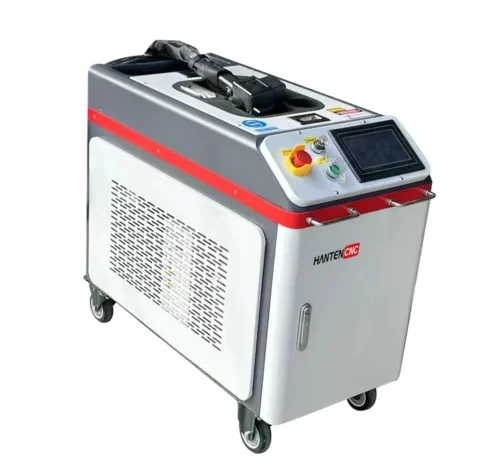How Does Laser Cleaning Work?

The laser cleaning method is getting more popular day by day. It is a cost-effective, eco-friendly, and easy-to-operate method that an ordinary person can use. However, many people need to learn how laser cleaning works.
This guide will explain the workings of laser machines. Whether you are an experienced person or a newbie, this insight will help you learn more about the basic principles of laser machines. So, let’s get started!
Basic Principles and Working of Laser Cleaning
The laser cleaning method applies the laser beam to the Material we aim to remove. The laser beam has more energy than the Material’s ablation threshold. Due to the higher energy (heat), the contaminants are removed.
The section below explores the basic principle of the laser cleaning method and details how the laser removes contaminants in straightforward steps.
1. Ablation Energy of Material & Energy of Laser Beam
First, the ablation energy we want to remove must be known. Every Material has its ablation threshold. For example, when cleaning the rusted steel rod, we must see the ablation threshold of the layer of oxide and rust.
Once we know the ablation energy, we will have to use a laser beam with more power than the Material’s ablation threshold. This will cause more energy (heat) to break down, vaporizing unwanted materials (rust, paint, or other things).
2. Apply the Laser Beam to the Material
Once we have set the energy of the laser beam, you’ll need to direct it towards the unwanted Material. The beam is usually applied as a spray. You don’t have to repeatedly put the beam in one place to remove the rust or unwanted Material.
Spraying the beam on the Material would be best, and it will do its magic. The powerful energy of the beam’s heat will overcome the Material’s ablation energy once the Material’s ablation energy breaks down or vapourize once it is matched.
3. Remove a Material in a Highly Selective Way
It is noteworthy that laser energy plays a crucial role in the cleaning process. If you apply the wrong power, it can affect the whole Material (along with the unwanted Material). Using the energy that only matches the threshold of unwanted Material is always recommended.
For example, while cleaning the rusty steel rod, you should only apply enough energy beams to match the ablation threshold of rust. However, if you don’t heed the beam’s energy, and if it reaches the steel’s ablation threshold, it will also start damaging the steel.
This logic is instrumental in helping to remove only selective Material. Since every Material has its ablation threshold, you should always match the threshold of the Material you want to remove.
4. Energy Absorption by Contaminants
Assuming that you know – every Material absorbs the energy. So, when you apply laser light, the contaminant or unwanted Material will absorb the applied energy (heat). Our applied heat will be greater than the ablation threshold, it won’t be able to sustain.
As a result of high energy absorption, the Material will break down into many smaller pieces. It can even be vaporized. Suppose the Material absorbs the energy and does not break. In that case, it means that you are applying lower power than the ablation threshold of that Material.
5. Thermal Effects & Physical Cleaning
In the lasering cleaning process, the thermal effect happens. When the unwanted Material absorbs the heat, its molecular bonds get broken. As a result, the unwanted Material (rust or any other contamination) blasts out from the surface of the actual Material.
Usually, during the thermal process, the unwanted Material is broken down into pieces. All you must do is remove those pieces from the Material’s surface. The laser cleaning process operates in such a simple way.
The good thing is that different laser machines work to remove rust and other contaminants. Suppose you are interested in learning more about how these machines work. In that case, you can read more and increase your knowledge about how laser cleaning machines work.
Benefits of Laser Laser Cleaning Process/Method
As I said earlier, laser cleaning is straightforward. It would help if you had a laser cleaner and were good at cleaning contaminants. Here are some positives that you gain while using the laser cleaning method:
- Cost-effective and easy to use
- Don’t require any maintenance
- Don’t require a team of professionals to operate
- Eco-friendly – and does not make any severe noise
- It is very selective – meaning it allows you to remove any unwanted material and keep the other Materials safe
Is the Laser Cleaning Process Safe?
The laser cleaning process is safer and more suitable than traditional cleaning methods. The user doesn’t interact with the Material directly and maintains distance. The laser beam does all the work in cleaning the metal.
Despite the safe laser cleaning process, the user must take precautions before using it. Here are some of the instructions that you must follow before using it:
- Wear safety suits
- Wear safety goggles
- Wear gloves and maintain a safe distance while using the laser machine
- While using the laser machine, ensure no flammable material is near you, as it can catch fire due to the laser beam’s heaters.
Conclusion
There is no doubt that the laser cleaning method is super helpful – however, it is relatively newer. People who still use the old method of cleaning the metals are not familiar with the works of these laser machines and their mechanisms.
These guides offer complete guidance on the working and functionality of laser machines and how they efficiently remove rust and other contaminants.
